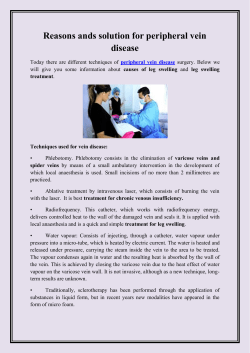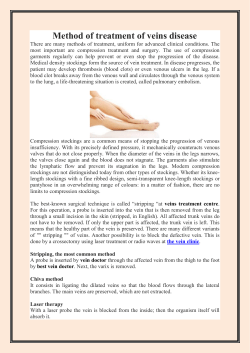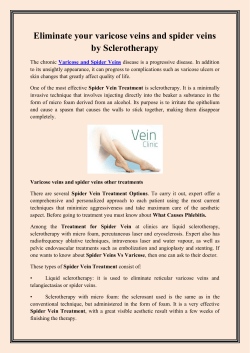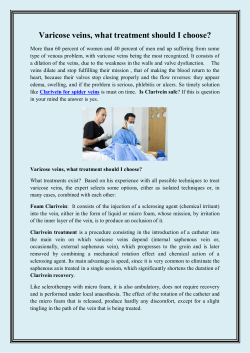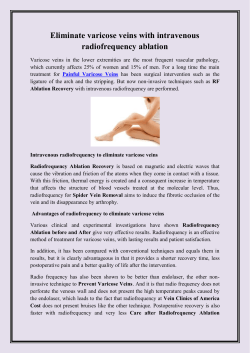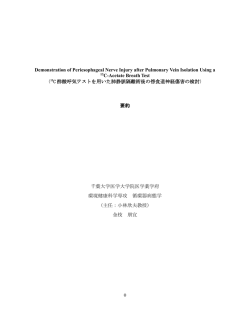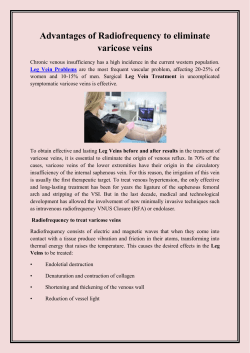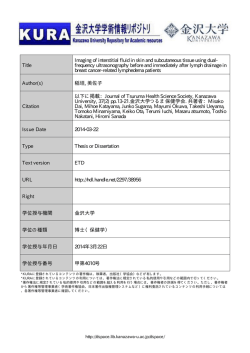
乳腺センチネルリンパ節と上肢リンパ管系との交通関係
第回臨床解剖研究会記録 ..~ ■シンポジウムリンパ浮腫に対する基礎研究および診断・治療法の進歩 乳腺センチネルリンパ節と上肢リンパ管系との交通関係 ―腋窩リンパ節郭清にともなう上肢浮腫の発生機序の検討― 三浦真弘1 安部美幸1 島田和幸2 1大分大学医学部医学系研究科生体構造医学講座(解剖学 1) 2鹿児島大学大学院医歯学総合研究科神経病学講座人体構造解剖学 はじめに 清手技における上肢浮腫回避のための温存構造因子に 近年,術後 QOL 向上の観点から乳癌根治手術にと ついても検討を試みた. もなう腋窩リンパ節郭清の意義再考や縮小手術の重要 対象と方法 性が乳腺センチネルリンパ節( MSLN )の概念導入 材料は,大分大・鹿児島大に供された女性成人解剖 とともに議論されている1).しかしながら,上肢浮腫 体 8 体を用いた.リンパ系の解析には腋窩全域の伸 回避に必要とされる MSLN を中心とした腋窩リンパ 展標本を作成したのち顕微鏡下裏返し剖出法を応用し 系(ALS )の正確な形態学的特徴や MSLN と上肢リ た.上肢から ALS へ流入するリンパ管の確認とリン ンパ系との交通関係の詳細については未だ不明な点が パ流入速度については,インドシアニングリーン 多い.本研究では, ALS の形態学的特徴を明らかに (ICG)蛍光 PDE 観察法を用いてカニクイザルにて解 するとともに, MSLN と上肢リンパ系との交通様式 析した.なお ALS の表記は乳癌取り扱い規約(2008) について種々の解剖学的検索を行った.また,腋窩郭 の分類に従った. Fig. 2. Schematic drawing of the lymphatic collateral routes between the mammary sentinel lymph nodes (LN) and lymphatic system of the upper extremity Fig. 1 ICG ‰uorescence images. The subcutaneus lymphatic stream was observed from the forearm to the deep axillary space (☆); it ˆnally reached level Ia lymphatic nodes (arrows) on each side of axilla (1a, 1b). Dotted lines indicate the white line of latissimus dorsi muscle (LD). PMa: M. pectoralis major 26 臨床解剖研究会記録 No. 12 2012. 2 AV LN: axillary vein LN, AVS: axillary vein sheath, IP LN: interpectoral LN, LD: latissimus dorsi muscle, MSLN: mammary sentinel LN, PMa: pectoralis major, PMi: pectoralis minor, SubC LN: subclavicular LN, SubP LN: subpectoral LN, SubS LN: subscapular LN, SupC LN: supraclavicular LN, VC: cephalic vein, VJI: internal jugular vein, VSS: subclavicular vein, VTD: thoracodorsal vein, VTEG: thoracoepigastric vein, VTL: lateral thoracic vein, VTS: superior thoracic vein 結 果 考 察 ALS は腋窩動脈系の走行変化(浅肩甲下動脈系列 MSLN は,乳腺から ALS へ向かうリンパ管流入数 SSS )にともない ALS の基軸(肋間上腕神経を基 から 1b CALN と胸筋 LN であると考えられた.剖査 準)2) が頭尾方向にシフトした.しかし,その基本構 所見で確認された上肢深層リンパ系と Ia 領域との側 築は個体間で共通の規則性が認められた.乳腺外側か 副路については,同様の所見が生体内 ICG 吸収路に ら起発したリンパ管の最初の流入リンパ節(LN)は, おいても検証できた( Fig. 2 ).乳癌根治手術にとも 80 は Level Ib 領域の中心腋窩 LN ( CALN ),残り なう腋窩 LN 郭清では, Level Ia 領域進入のランド 20 は胸腹壁静脈内側の胸筋下 LN に注いだ.上肢 マークとして White line の露出操作,また,腋窩静 深層リンパ系は,腋窩血管鞘( AVS )内を上行した 脈露出操作において上肢から腋窩領域との側副交通路 のち AVS を逸脱して広背筋の腱性部( White line ) が損傷する危険性が高いことが示唆された. 上縁から Level Ia 肩甲下 LN・腋窩静脈 LN に流入す る経路と,Level II 胸筋下 LN に注ぐ 2 系統の側副路 (Fig. 1)が認められた.両経路は最終的に Level II Level III を介して左静脈角へ注いだ.ICGPDE 観察 において, AVS 内リンパ本幹の一部が反回して Ia . LN に向かう側副路の存在が確認された(Fig. 2) 結 語 White line 上縁結合組織と AVS は術後上肢浮腫を 回避することに必要な温存構造因子と考えられた. 文 献 1) Noguchi M. 2002. Sentinel lymph node biopsy and brest cancer. Br J Surg 89: 2134 2 ) 三浦真弘ほか. 2007 .腋窩領域リンパ管系と N. intercostobrachialis 後枝との位置的関系.臨床解剖研究会記録 7: 1415 The anastomotic connection between the mammary sentinel lymph nodes and lymphatic system of the upper extremity: a study on the pathogenesis of upper limb lymphedema following radical axillary lymph node dissection Masahiro MIURA1, Miyuki ABE1, Kazuyuki SHIMADA2 of Human Anatomy, Faculty of Medicine, Oita University, 2Department of Neurology Gross Anatomy, Kagoshima University Graduate School of Medical and Dental Sciences 1Department The signiˆcance of the radical axillary lymph node dissection as part of radical mastectomy and the importance of breast reductive surgery from the standpoint of improving postoperative quality of life (QOL) have been among the topics recently discussed in relation to the concept of mammary sentinel lymph nodes (MSLNs). However, little is yet known of the morphological characteristics of the axillary lymphatic system (ALS) and MSLNs, and the true nature of the anastomotic connections between the upper extremity lymphatic system (UELS) and MSLNs. Thus, these issues need to be addressed to prevent upper extremity edema. This study attempts to better explore the morphological characteristics of the ALS, and to anatomically examine the communication patterns between the MSLNs and UELS. The structural factors associated with prevention of the upper extremity edema after axillary dissection are also discussed. The specimens were taken from 8 dissected bodies of adult women in Oita University. We examined the lymphatic system using the reverse-dissection method after whole-mount preparations. Indocyanine green (ICG) ‰uorescence imaging was used in combination with a Photodynamic Eye (PDE) for vital observation of the lymphatic vessels ‰owing from the upper extremities to the ALS. The ALS changed its direction following the course of the axillary artery (the series of superˆcial subscapular arteries), and aligned itself along the craniocaudal axis. However, the fundamental structure was demonstrated to be a shared regularity among individuals. The majority (80 percent) of lymph nodes (LNs), which were ˆrst connected by lymphatic vessels from the superˆcial region of the mammary glands were level Ib central axillary LNs (CALNs), and the remaining nodes (about 20 percent) were level II subpectoral LNs. The deep lymphatic system of the upper extremities followed a pathway which ascended via the axillary vascular sheath (AVS), then ran away from the AVS along the upper edge of the tendinous part (the white line) of the latissimus dorsi muscle in the level Ia subscapular LNs and axillary vein LNs, and the two auxiliary pathways drained into the subpectoral LNs. Furthermore, the observation by PDE revealed the ‰uorescent traces of an auxiliary pathway from the lymphatic route in the AVS to the Ia region. MSLNs were thought to be CALNs and pectoral LNs based on the number of in‰owing lymphatic vessels originating from the mammary glands. It was suggested that the axillary dissection procedure may damage the collateral pathways that ‰ow from the upper extremities into the ALS during exposure of the axillary veins, and the white line, a key landmark for entry into level Ia. The AVS and connective tissues at the upper margin of the white line were thought to be important structural factors necessary for preventing postoperative upper extremity edema. Key words: axillary lymph node, mammary sentinel lymph nodes, upper extremity edema, gross anatomy 乳腺センチネルリンパ節と上肢リンパ管系との交通関係 27
© Copyright 2025
